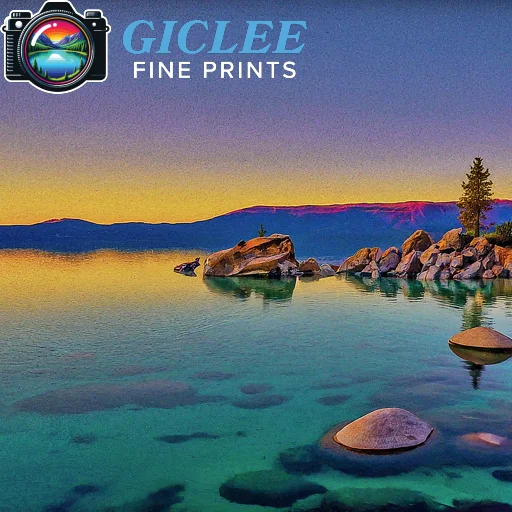
Selling photography prints is a great way for photographers to turn their creative work into a profitable business. Whether you’re an amateur looking to sell your work for the first time or a professional wanting to expand your revenue streams, understanding how to prepare and sell photography prints effectively is key to success. At Giclee Fine Prints, we help photographers produce high-quality prints that meet professional standards.
Curate Your Best Work
Before you start selling, you need to curate a collection of your best photos. Quality over quantity is essential, as selling photography prints relies on showcasing work that will attract buyers and demonstrate your artistic style. Focus on creating a portfolio that highlights your strengths, whether it’s landscapes, portraits, fine art, or abstract photography.
Key Tips:
- Select Your Strongest Work: Choose images that reflect your unique style and expertise. Avoid including every photo you’ve ever taken—only pick your best shots.
- Create a Cohesive Collection: Ensure your portfolio has a theme or cohesive aesthetic, as buyers often prefer a collection that tells a story or has a unified look.
- Edit and Enhance: Make sure your photos are professionally edited and ready for print. Consider color correction, retouching, or enhancing contrast to ensure each image is perfect.
Best For:
- Landscape photographers who want to highlight natural beauty with vivid colors and sharp details.
- Portrait photographers creating artistic prints with emotion and depth.
Choose the Right Printing Medium
When selling photography prints, it’s important to offer a variety of print mediums to appeal to different buyers. Popular choices include canvas, fine art paper, and metal prints, each offering a unique aesthetic and quality.
Popular Printing Mediums:
- Canvas Prints: Perfect for creating a gallery-style look, canvas prints give photos a textured, artistic appearance. The gallery wrap option, where the image wraps around the sides of the frame, provides a frameless, contemporary look.
- Fine Art Paper: Ideal for photography with subtle details and rich tones, fine art paper offers a smooth, matte finish with exceptional color accuracy. It’s often used for high-end prints and exhibitions.
- Metal Prints: For a sleek, modern presentation, metal prints deliver vibrant colors and sharp contrast. They are durable, lightweight, and perfect for contemporary decor.
Best For:
- Photographers selling high-end art prints for exhibitions, galleries, or home decor.
- Landscape and abstract photography where large-format canvas or metal prints enhance the visual impact.

Understand Pricing and Costs
Setting the right price for your photography prints is a delicate balance between covering production costs and ensuring profitability, while still offering competitive prices to attract buyers.
Pricing Factors to Consider:
- Printing Costs: Factor in the cost of printing each piece, which will vary depending on the size, medium (e.g., canvas, fine art paper), and printing process (e.g., giclee printing). Ensure that your selling price covers these costs.
- Materials: Don’t forget to account for the cost of frames (if applicable), packaging, shipping, and any additional handling fees.
- Profit Margin: Set a profit margin that reflects the time, effort, and creative input you’ve invested in each piece. A typical margin might range from 30% to 50% above production costs.
Best Practices:
- Offer a Range of Prices: Have a variety of price points to cater to different budgets. Smaller prints or limited-edition runs can be priced higher for exclusivity, while more affordable prints can appeal to a wider audience.
- Research the Market: Look at what other photographers in your niche are charging for similar work to get a sense of competitive pricing.
Best For:
- Amateur photographers looking to break into the market by offering affordable photography prints.
- Professional photographers creating limited-edition runs with higher price points for exclusivity.
Prepare Files for High-Quality Prints
The quality of your photography prints is directly related to the quality of the file you send to the printer. Ensure your files meet the resolution, size, and color requirements for flawless prints.
File Preparation Tips:
- High Resolution: Always use files with a minimum of 300 DPI (dots per inch) to ensure sharp, clear prints. This is particularly important for large-format prints like canvas or metal prints.
- Correct Sizing: Make sure your file size matches the print dimensions. For example, if you’re selling 16×20-inch prints, ensure your image is sized accordingly without losing detail.
- Color Profile: Use the appropriate color profile, such as Adobe RGB for more accurate color reproduction. Consider soft proofing with ICC profiles to see how your colors will print.
Best For:
- Photographers preparing large-format prints where detail and color accuracy are critical.
- Artists offering premium fine art paper prints that demand high-quality resolution and color fidelity.

Choose an Online Platform to Sell Your Prints
To start selling your photography prints, you’ll need an online platform that allows you to reach potential buyers and manage orders easily. There are many options available, from self-managed websites to online marketplaces.
Popular Selling Platforms:
- Etsy: A well-known marketplace for handmade and artistic products, including photography prints. It’s a great option for beginner photographers looking to build a following.
- Shopify: For photographers who want full control over their brand, Shopify allows you to set up your own online store, complete with customizable features and integrated payment processing.
- Print-on-Demand Services: Services like Fine Art America or Redbubble allow you to sell prints without handling production or shipping. You upload your images, and they handle the rest.
Best Practices:
- Optimize Your Listings: Use high-quality images of your prints and write compelling descriptions that highlight the unique aspects of your photography.
- Social Media Promotion: Leverage platforms like Instagram, Facebook, and Pinterest to promote your photography and drive traffic to your online store.
Best For:
- Beginner photographers who want a simple platform like Etsy to start selling their work.
- Professional photographers looking to build a personal brand and manage their own store through Shopify.
Market Your Photography Prints
Once your online store is set up, you’ll need to market your photography prints to attract buyers. Effective marketing is key to building awareness, driving traffic, and making sales.
Marketing Strategies:
- Social Media Marketing: Share your work regularly on social media platforms, engage with your audience, and use hashtags relevant to your niche (e.g., #landscapephotography, #fineartprints) to expand your reach.
- Email Marketing: Build an email list of potential buyers or followers interested in your work. Send newsletters with updates on new collections, limited-edition runs, or special promotions.
- Collaborate with Influencers: Partner with influencers or bloggers in your niche who can help promote your prints to a larger audience.
Best Practices:
- Offer Limited Editions: Create a sense of urgency by offering limited-edition prints or exclusive collections that appeal to collectors.
- Attend Art Shows or Pop-Up Markets: If possible, sell your prints in-person at local art shows, galleries, or pop-up markets to reach new customers and gain exposure.
Best For:
- Photographers looking to increase their visibility and attract new clients.
- Artists seeking to build a following and sell more prints online.
Contact Us
Our address is: 3816 Pioneer Trail Ste #3, South Lake Tahoe, CA 96150
Email: Info@gicleefineprints.com
FAQs
The best print medium depends on your aesthetic and target audience. Canvas prints are popular for a textured, artistic look, while fine art paper offers smooth finishes ideal for high-end photography prints.
Consider your production costs, the quality of your work, and market trends. Aim to cover your costs while setting a profit margin of around 30% to 50%.
A minimum of 300 DPI is required for high-quality prints, especially for large-format pieces like canvas or metal prints.


